The best helmet camera for motorcycles, cycling and adrenaline junkies
Pick up the best helmet camera to record your two-wheeled travels and outdoor pursuits for safety or fun.
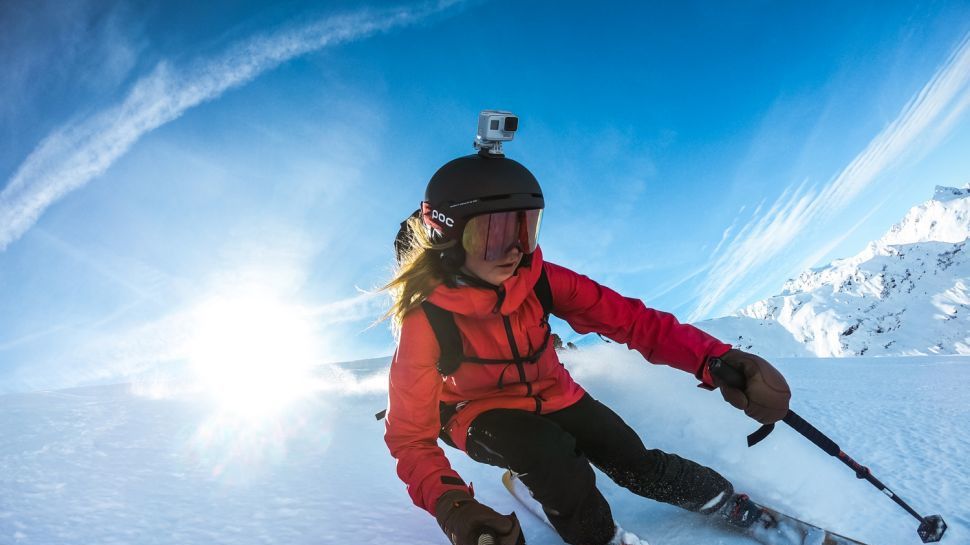
With one of the best (or cheapest) helmet cameras you can bring your rides to life! Whether you're on a bike, a motorbike, a snowboard or even a horse, you can capture everything that happens, completely hands-free. This isn't just for fun; it can be practical – for insurance, creating training, or serious filmmaking. A good helmet camera can be relatively inexpensive, and provide you with many hours of fantastic, high-quality footage.
There are a few things to think about when picking a good helmet camera, while many of the best cameras for cyclists will also double up as a great helmet cam there are a few differences to look out for.
The most important factor is quality. We measure that both in terms of resolution – you'll want at least 4K video these days, though some can top that, or even hit 8K! The ability to cope with shake, termed 'image stabilization,' is also key – the last thing you want is shaky footage – and, finally, it pays to think about whether you'll only be using it in the day, or whether low-light capture matters to you.
There's also the issue of battery life; you're unlikely to be changing batteries while a camera is stuck to your bike helmet. Different mounting options, and some require the purchase of an extra kit to be mounted to a helmet. Do you want integrated lights to make it easier to see at night, or GPS to record your route (good if you tend to leave your camera phone at home).
So there's a lot to consider. Fortunately, we've done that considering for you, and come up with a range of cameras that offer feature sets optimal for helmet mounting, at a range of prices to suit every budget. Read on to discover the best helmet cameras you can buy!

Adam Juniper has been using GoPros since the very start, attaching them to drones and dropping them out of the sky. He's also has bursts of enthusiasm for cycling (admittedly somewhat weather-linked), and his cycle helmet always has an action camera mount on it ready to test the latest cam!
best helmet camera: our top picks
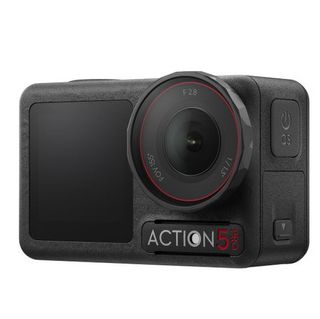
Best overall
The DJI Osmo Action 5 Pro is the best choice for mounting and forgetting whatever the lighting conditions; it has amazing battery life and a large image sensor for low light. Pros will love the 10-bit video and wide dynamic range. The fact it's also cheaper than the GoPro it outclasses seals it!
Read more below...
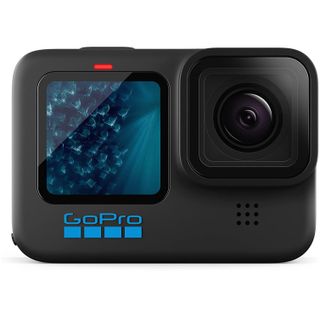
Best cheap helmet GoPro
The older Hero 11 benefits from a better price and has all the features you'd want – including built-in GPS. The 8:7 mode is perfect for making TikTok's and Instagram Reels, it can also capture 27MP stills, and 5K video at 60fps.
Read more below...
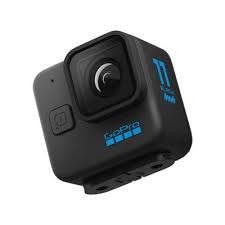
Best for compact size
If you're an extreme sports enthusiast, we highly recommend the GoPro HERO 11 Black Mini for capturing any adventure without the burden of weight or battery-draining displays like the HERO 11 Black
Read more below...

Best Tiny
Insta360 has not been afraid to innovate, and the 'Go' series of cameras are the 'Airpods' of the camera world. It can be worn nearly anywhere, including a helmet mount, and for shorter journeys, it is incredibly light while still packing stabilized 4K.
Read more below...
The best helmet camera
Why you can trust Digital Camera World
Best overall
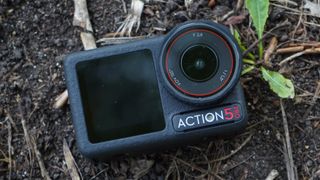
Specifications
✅ You're looking for good battery life
✅ You want to use the camera in day and night
❌ You don't want to put the GPS in an external 'watch'
❌ You fancy the idea of swappable lens adapters
DJI has, in our view, pipped GoPro for the best action camera crown, at least when you use your head over your heart. Professionals, certainly, will see the larger image sensor (which captures better detail in lower light) as an obvious winner, not to mention the 10-bit color system with very broad dynamic range. Plenty of scope for grading.
All that tech is relevant when used as a helmet camera too – after all, not everyone rides in the daylight. If you're thinking of a camera to potentially catch evidence, or just get cool night-time shots, then a larger sensor matters. The relatively long battery life is a massive boon too – you can be recording – realistically – without touching the camera for well over three hours; 4 in lab conditions at 1080P, apparently though my tests were all outdoors and 'real life'.
One thing DJI didn't include that I'd have liked was a GPS system in the camera for measuring speed (though there is a pressure sensor that can record altitude). Because the camera is cheaper than the GoProm, you can add DJI's optional GPS Bluetooth Remote the total price still seems reasonable – this watch-like device also offers a big-button remote switch you can easily operate with leather gloves on, sidestepping touchscreens!
Alternatively, if you've already got a Garmin or Apple watch, you can get GPS data from that and just enjoy the savings.
DJI also have social media creators in mind with a new subject-tracking feature, so if you want to mount the cam and do a walk and talk, it can follow you and keep you in a vertical crop (for example).
Finally, though DJI's magnetic mount is not quite as slick as the new one with the GoPro Hero 13 and Insta360's Ace Pro because it only works one way; other accessories like the battery charging hub (if you opt for it) are leagues ahead of their competition in terms of design quality. It's also testament to DJI's attention to detail that, though this camera has new batteries, you can still use the Action 4 batteries too – unlike the new GoPro.
Read my full DJI Osmo Action 5 Pro review for more and to see samples, or my GoPro Hero 13 Black v Action 5 Pro comparison.
Best cheap premium
Best cheap helmet GoPro
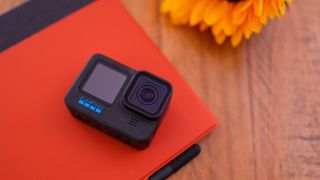

Specifications
Reasons to buy
Reasons to avoid
Though it is no longer the latest model, the GoPro Hero 11 is a good deal for a few reasons (not least the fact the Hero 12 was worse as a helmet cam because GoPro took away the built-in GPS).
That means you're getting most of the features of the new GoPro Hero 13 Black, but for less of the money – the only thing not included is the fancy lens swapping system and timecodes, but the later certainly is probably not relevant for most riders.
The almost square sensor is able to capture 8:7 content which is useful for making TikTok's and Instagram Reels from the same recording, it can also capture 27MP stills, 5K video at 60fps, 4K video at 120fps or 2.7K up to 240fps for some serious slow-mo shots. If you're after the best stabilization available, excellent video quality (unless shooting in low light), and some fun new modes such as light painting, go for the GoPro Hero 11.
Not only is it capable of all the above but the introduction of the 8:7 aspect ratio means you can shoot in 5.3K resolution in 8:7 at up to 30fps, and its footage can be losslessly cropped to create new 4K portrait, landscape, and square clips from a single video. It's a shame the low light performance hasn't been massively improved but it's something we can let slide with all the other upgrades it's had.
Read our full GoPro Hero 11 Black review
GoPro Subscription explained: what you get, and is it worth it
Best compact
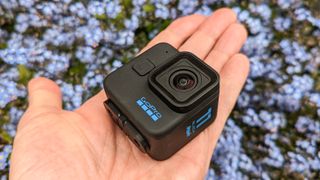
Specifications
Reasons to buy
Reasons to avoid
If you're an extreme sports enthusiast, we highly recommend the GoPro HERO 11 Black Mini for capturing any adventure without the burden of weight or battery-draining displays like the HERO 11 Black. We find it particularly appealing that this camera seamlessly integrates with GoPro's Quik app and even though it doesn't have a dedicated photo mode, the type of people who it's aimed at will be more concerned with video anyway. During our testing, we found it effortless to connect it to our smartphones, allowing us to adjust video settings, frame our shots, and review our recordings within seconds of capturing them.
What impressed us, even more, was the clever workaround for the absence of a dedicated photo mode which allows you to screen grab 24.7MP stills from 5.7K video. The camera's compatibility with USB-C batteries enabled us to extend its built-in battery power, ensuring longer recording sessions. The HERO 11 Black Mini delivered outstanding video quality, making it an ideal choice for GoPro users who prefer a minimalist approach to their equipment
Read our full GoPro Hero11 Black Mini review for more details
Best tiny
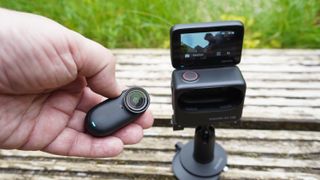
Specifications
Reasons to buy
Reasons to avoid
If you're looking for something a lot more compact than even the standard action camera, then the Go 3S – in black or white – might be what you have in mind. It is light enough, and has a built-in magnet. This means, as well as a cap, it can be worn on clothing like a microphone, and there is a pendant you can wear so you can just pop the cam onto and off your chest. Of course, more relevant here, you can also get a helmet clip, or even a baseball clip if that's the only weight you want to put on your head! That's flexibility – worth considering if you don't want to buy too many cameras!
You're not actually sacrificing a lot either because the camera comes with an action-camera-sized 'Action Pod' which is magnetically drops into to top up its roughly 30 minutes of charge. Even when not in the case, you can preview view the 4K video which is almost like magic (though, to be fair a drone can do this from rather further, so I shouldn't be too impressed!) The Action pod also has a flip screen system, like Insta360's action camera the Ace Pro series, so you can shoot and get a view from all kinds of angles.
It all adds up to a surprisingly versatile system though for any kind of long ride you'd either want to mount the camera in the ActionPod (because this gives it a much longer battery life, but brings the size and weight back up in line with other action camera), or only use it for rides under 30 minutes.
That's a choice you need to make for yourself, but it's good to know it's an option and – in good light at least – the 4K video and stabilization is up there with most action cameras.
Read my full Insta360 Go 3S review for more details and sample clips
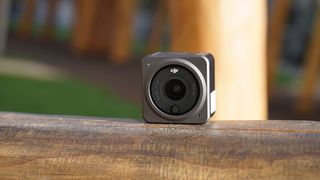
Specifications
Reasons to buy
Reasons to avoid
Given GoPro's market dominance, rival action camera manufacturers have been getting seriously creative in an attempt to establish their own niche. DJI's first foray, the Osmo Action, was a fairly conventional action camera, albeit with a few nifty features like the front-facing screen, which GoPro promptly stole. The Action 2, however, is a different beat entirely. This tiny cuboid weighs just 56g on its own but has a magnetic system with which you can add optional modules, such as the Front Touchscreen Module, or the Power Module, which adds an extra battery and will probably be of more interest to bike riders.
The footage it captures looks excellent – it tops out at 4K, rather than the 5.3K of the GoPro HERO 10 Black, but let's be real, this is probably enough for most purposes. Having the RockSteady 2.0 also helps smooth out your footage (though it's worth being aware that it won't work at all resolutions and frame rates). In our review, we were very impressed by the DJI Action 2, praising, in particular, the value for money in the package that DJI has put together here. It's an excellent choice of a helmet camera.
Read our full DJI Action 2 review for more details
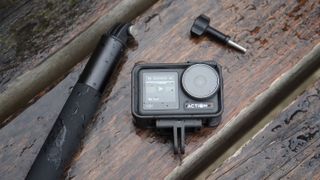
Specifications
Reasons to buy
Reasons to avoid
DJI's latest action cam comes in the form of the Osmo Action 3. Balancing quality and price, it delivers very good, stabilized 4K video at up to 120fps. Extreme batteries which can last up to 3 hours are included as standard and while we do miss the modular design, the new style is more similar to that of a GoPro and is a lot easier to manage.
Unlike the GoPro however, it won't push you towards signing up for a subscription and it's cheaper upfront anyway. It uses DJI's RockSteady stabilization and HorizonBalancing so even when the camera is moving quite aggressively, you can still capture smooth video.
All in all, we were very impressed with DJI's latest offering - the Mimo app has also improved so you can download images, use it as a remote or even edit images in-app.
Read our full DJI Osmo Action 3 review for more details
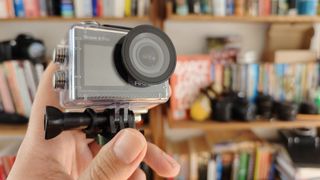
Specifications
Reasons to buy
Reasons to avoid
If you're on an ultra-strict budget, then Akaso action cameras are well worth considering, as the Chinese manufacturer makes a range of options that come around and under the $100 mark.
The Akaso Brave 4 Pro is a few years old now but represents really good value, and comes with a stack of accessories including helmet mounts. It's pretty amazing to get a 4K camera with stabilization for a price as low as this, but Akaso makes it so, and the footage generally looks decent.
We found in our review that the processor can sometimes stutter at higher resolutions if there are sudden light changes, but it's fine if you dial it down to Full HD, which gives you higher frame rates to work with anyway.
Read our full Akaso Brave 4 Pro review for more details
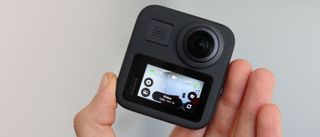
Specifications
Reasons to buy
Reasons to avoid
The GoPro Max is a different beast entirely from other GoPro cameras (hence the lack of the "Hero" moniker). It's capable of shooting 360-degree video and spherical video with matching audio, as well as shooting in a whopping 6K 30p resolution. Might this be slight overkill for a camera mounted to a helmet? Perhaps, but if you do want to capture 360-degree views of your rides or surfs, this is certainly the way to do it. We gave it the highest possible score in our review, in part because this camera simply gives you so many options to play with.
The GoPro Max also captures its audio in 360 degrees, so your viewers will be able to immerse themselves in the action. it's got plenty of features from the Hero 8, like the HyperSmooth stabilization, and also has a number of different digital lens settings that allow you to capture different perspectives on the action. Then there's also voice control, not to mention the huge range of GoPro accessories. It's expensive, but we reckon you get a lot for your money.
Read our GoPro Max review for more details
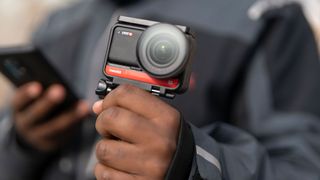
Specifications
Reasons to buy
Reasons to avoid
This is the original version of the upgraded Insta360 RS Twin Edition listed above, and it's available for a significantly lower price. The 1-inch wide-angle lens is included with this addition but you could buy a 360-degree lens separately. The bigger 1-inch sensor is capable of recording 5.3K video at 30p and it's capable of recording in H.264 and H.265 codecs which means you can reduce the file sizes but keep the image quality. The larger sensor also means its low light performance is excellent which is good considering it doesn't have a built-in light.
Insta360 uses their FlowState Stabilization algorithm that supports both in-camera stabilization and post-stabilization so you can shoot smooth video that can be refined when editing. There are lots of accessories to choose from with the Insta360 so you can either mount it to your helmet or handlebars. It doesn't have the waterproof capabilities of other action cameras and despite needing the case to be fully waterproof to 5 meters it doesn't add any rubber seals.
The Insta360 One R 1-inch can be voice-controlled, via Bluetooth or via the purpose-designed app for your smartphone. The camera itself is pretty durable so would survive a knock or two.
Read our full Insta360 One R 1- Inch Edition review for more details
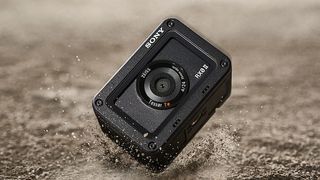
10. Sony RX0 II
Specifications
Reasons to buy
Reasons to avoid
The Sony RX10 II is considerably more expensive than any other helmet/action cam on the list but it does have a 1-inch sensor that will make it noticeably better in low light conditions. This is almost definitely aimed at the adventurers rather than the safety seekers who don't necessarily need such a large sensor.
The RX10 can shoot great-looking 4K video at 30p as well as high-speed video at an incredible 1000fps. This feature will allow you to create some unforgettably slow-motion scenes which look very cool in a video for social media. It's designed to withstand the elements and thanks to its extensive shockproofing and crushproofing, it should survive a tumble on your bike. It will probably even fair better than you do...
All this does come at a premium price, and if you don't need the ultimate in sensor quality from a helmet camera, it's probably worth checking out one of the cheaper options on this list. Still, if you need the best, get the best.
FAQs
Do I really need 6K video?
The long and short of it is no, you don't. However, 6K footage is extremely high quality so if you want to take still screen grabs or create extremely professional looking videos, the higher the resolution the better. You will pay more for a 6K helmet camera so if budget is tight you might be better off with something that shoots 4K or even Full HD. If you're just posting to social media, you wouldn't reap the benefits of 6K anyway.
What size memory card will I need?
This is completely dependent on how long you want to shoot for, whether you have access to unload content and whether your helmet camera has a maximum capacity SD card. Most GoPro's will take a microSD card ranging from 16GB to 1TB but the bigger the memory, the more you will spend.
What speed does my memory card need to be?
This is determined by the cameras maximum video bitrate so it differs from camera to camera but for example, if you have the GoPro Hero 11 Black, it has a max bitrate of 120mbps so anything above that will work without any buffering issues.
How we test cameras
When it comes to the best helmet cameras, our team of reviewers tests them out in real-world conditions to get an idea of how well they perform. We test out all the different photo and video settings to get a feel for the kind of imagery the camera is capable of capturing, and also assess the user experience, as well as the usefulness of any connectivity features like Wi-Fi, Bluetooth or GPS. We look at helmet and handlebar mounting options too, to get a sense of how easy the camera is to use in this capacity. Read more about how we test and review at Digital Camera World.
Get the Digital Camera World Newsletter
The best camera deals, reviews, product advice, and unmissable photography news, direct to your inbox!

With over 20 years of expertise as a tech journalist, Adam brings a wealth of knowledge across a vast number of product categories, including timelapse cameras, home security cameras, NVR cameras, photography books, webcams, 3D printers and 3D scanners, borescopes, radar detectors… and, above all, drones.
Adam is our resident expert on all aspects of camera drones and drone photography, from buying guides on the best choices for aerial photographers of all ability levels to the latest rules and regulations on piloting drones.
He is the author of a number of books including The Complete Guide to Drones, The Smart Smart Home Handbook, 101 Tips for DSLR Video and The Drone Pilot's Handbook.
- Hannah RookeFreelance contributor